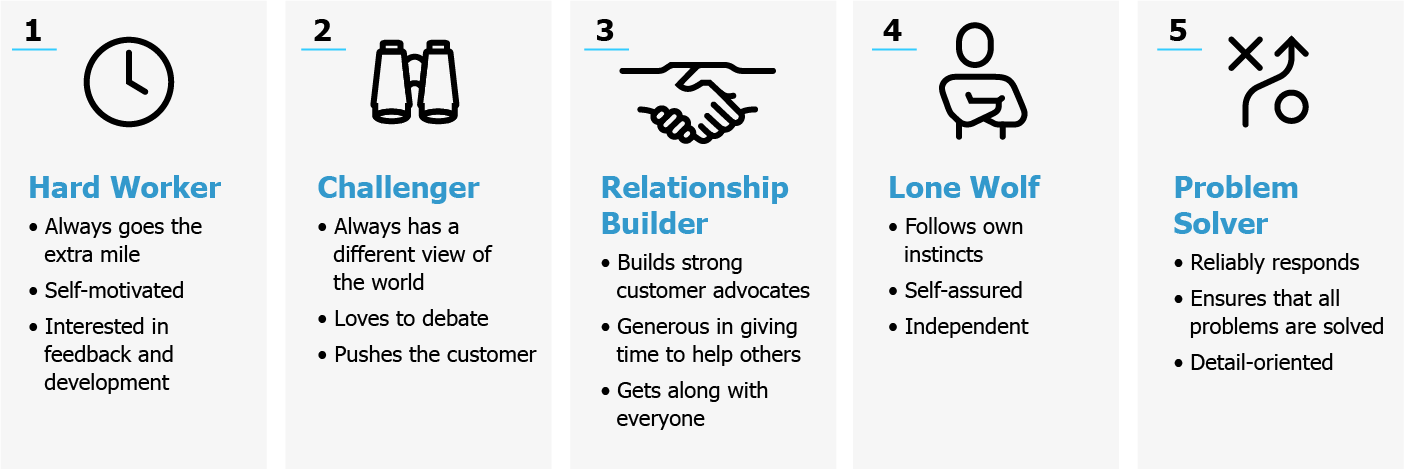Some sellers always be closing. Some sellers sometimes be closing (the month with a missed quota). What separates these two sellers?
A decade ago, researchers from CEB Inc., a talent management insights company now part of Gartner, published a book that revolutionized the selling industry: The Challenger Sale. In the book, the authors note the stark performance differences between the Challenger seller and the other seller profiles, which Gartner research further supports.
Top sellers outpace the rest
Gartner researchers suggest that most sellers fall into one of five personas or profiles as they’re communicating with prospects, with one seller outpacing the others:
The five profiles of sales professionals

Challengers out-perform the others by a landslide

- Hard worker: The hard worker is a self-motivated person unafraid to cold call anyone, anywhere, anytime. They show up to work early and leave late. They ask for feedback and how to improve, and believe that their sheer force of will lead them to sales victory. Yet just because they work hard doesn’t mean they outperform.
- Relationship builder: The relationship builder is the most prevalent sales persona delivering core performance to the organization. This is a very common sales approach, where they build long-term relationships with prospects and customers. They have a congenial spirit as team players willing to help however they can. Yet regarding high performance, these are the least effective salespeople.
- Lone wolf: The lone wolf is the maverick, the self-assured, self- confident salesperson driven by instinct. They have a “good nose” for deals and influential relationships. They like to be alone in their decision making, and it often pays off: Their instincts net them a second-place finish among high-performance salespeople. Yet one group is still superior.
- Problem solver: The problem solver is the detail-oriented person in the bunch. They aim to intimately understand the prospect’s problem, and they’re talented communicators that help the prospect analyze what’s working and what’s not working, with practical solutions to address their needs. Yet these approaches don’t always understand the underlying problems, and their performance shows.
- Challenger: The challenger leaves the others behind in terms of performance. Why? Because they have business acumen and a unique worldview to understand the prospect’s problem and how to present the solution better than anyone else. Their edge is their confidence to push and challenge the prospect toward considering an alternative view, what Gartner calls “commercial insight” or “commercial teaching.” This skill is invaluable, but it’s not always easy to grasp. It requires an extraordinary knack for great communication.What is it about Challengers’ communication that so outperforms the others? And how can leaders get there?
 Top sellers do these three things
Top sellers do these three things
Let’s further break down the skills Challenger reps have in common, highlighting their talent for communication.
Define the pain point
Most of us think we know what our problems are. Yet we often need greater insight to understand the why beneath our problem. Leaders may think pipeline volume is down 15% this quarter (the problem), but do they know why (the insight)? Sometimes the why is unclear, or the correlation has little causation.
That’s where top sellers shine. They understand the prospect’s business well enough that they can pinpoint the real pain point, separating the signal from the noise. This insight might be counterintuitive to preexisting notions of what the problem might be.
This skill is what Gartner researchers call “commercial insight.” David Anderson, practice leader at Gartner, argues that “sales leaders must arm reps with commercial insight to push beyond presenting a new idea to actually undermine an existing one.”
Sales leaders and marketers may think that thought leadership is the way to communicate their ideas in a way that moves prospects toward purchase decisions. However, Anderson says, “Rarely will thought leadership alone cause customers to change their views or prompt immediate action.”
What can they do? Gartner argues that four attributes of commercial insight can make sellers better communicators:
- Highlight unique strengths to generate customer appreciation for your unique strengths
- Challenge customer assumptions in a way that persuades them
- Catalyze action to advance the sales cycle
- Scale across customers in a way that does not cause burden reps or resourcesCommercial insight, they say, “is typically developed by combining information, such as facts, data, industry trends, experiences and observations with customer needs, like business growth, increasing profits and reducing attrition, to create a unique conclusion.”We’ll talk about this more later on.
Reframe the issue
Next, though similar to the previous point, top sales reps reframe the challenges prospects face with new information they haven’t yet considered. Even before that, however, great sellers first explain to the prospect why they need to change at all.
That’s where the “reframe” comes into play. Top sellers don’t just respond to their prospects’ needs — they redefine them. They break the news to them that their problems will not be solved with inaction or the solution they’ve imagined.
Few sellers really know how to do this. “Astonishingly,” Jeff Michaels says in the same article above, “the results showed that 86% of the time, the rep’s message had no commercial impact whatsoever. This meant that only 14% of the time, the rep communicated their message in a way that suggested a reason for change.”
What’s missing?
As mentioned before, the prospect’s understanding of the problem may be built on untrue assumptions. For example, one writer explains how he teaches sellers to reframe the issue this way:
Many people assume that when they run out of closet space, it’s because they have too many clothes or too small a closet. The reality, however, is that they use plastic hangers that are seven times thicker than wire hangers. If dry cleaners used plastic hangers, they would need facilities 30% larger than the one they built. So, by simply switching out your plastic hangers for wire hangers, you can increase your closet space by 30% for a fraction of the cost of a renovation.
This is a small example of a reframe that leads to the solution, but the important point is not to lead with the solution but to the solution. Communication and a detailed, proper understanding of the prospect’s business become keys. Pairing that with well-placed data (7x bigger, 30% larger) cinches it.
In sum, to get there, you need to live in your customers’ shoes, understand their challenges, clearly communicate your big idea, and then deliver a good narrative to close the deal.
Create a compelling narrative
To do the above well, sales reps need to create a compelling narrative with their communications to prospects. With the myriad messages and overwhelming data bombarding prospects every day, top sellers make sense of the mania, turning chaos into clarity.
Another section of Gartner research illustrates the importance of the sense-making seller, while others similarly describe the need for the sense-making leader. The sense maker, in contrast to the “giver” and the “teller” of information, acts instead as a guide to understand the complex conversations across the web and business press, especially as it relates to the prospect’s business.

The sense maker helps reduce the buyer’s skepticism during the sales process while at the same time helps to increase their confidence that they’re making the right decision. Gartner research indicates that sense- making sellers close higher-value deals with little regret after the decision is made.

That’s why sellers need to be expert communicators who craft stories that inspire action. The impact of good storytelling leads to a results-orientated interaction, moving clients’ focus off the cost of the product or service to the outcomes on the other side. In other words, the conversation becomes about value instead of cost. Think outcomes, not price.
As you progress in a sales conversation, especially if you’re selling a broad and complex solution, you need to have the ability to contextualize what you’re saying to different audiences. The solutions will have similar components, but it needs to sound different to each person to address individual cares within the buying committee.
So, what separates top sellers from rest can be a series and not just one piece.
 Teach these skills to your sales reps with business storytelling
Teach these skills to your sales reps with business storytelling
Hybrid work offerCombining the above three skills with business storytelling can transform your sales conversations. Why does this work so well? Business storytelling helps break through the noise surrounding the buyer, but also helps them to reframe their problem with commercial insight and sense-making. In other words, it combines the most effective skills of the top sellers amid a complex selling environment.
It may take time for sellers to deeply understand the details of a prospect’s business, but adding storytelling skills can help present those assumptions and problems in a meaningful way. For example, neuroscience research has shown that bringing concrete visuals and interactivity into your presentation can dramatically improve results.

Organizations all over the world have helped their employees develop these skills through training and other resources, transforming their sales approach to bring in high-value customers more quickly.
We’ve seen that one of the biggest catalysts for sales initiating a search for communications vendors is an observed correlation between sales presentation skills and salespeople’s results. By using the above skills, sales leaders can create a more consistent language and communications culture across the sales team through expert communications training.
It’s time to make great communication a part of your selling brand.


